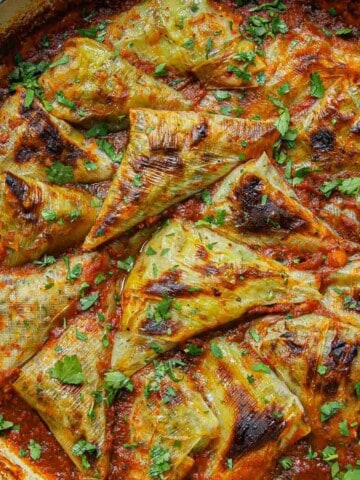This poultry brine recipe is a beautifully balanced mix of earthy herbs like sage and thyme with warming notes from spices like cinnamon and star anise, all married together with bright fresh flavor notes from raw garlic and citrus.
Mix up a batch and follow the simple method here for juicy birds every time.

My mother in law's holiday turkey is always perfect - juicy all the way into the deepest part of the breast with delectably crispy skin on the outside. Each year we praised the juiciness of the meat and beautiful balance of flavors, never really knowing how she did it.
Then one year she told us, and the answer was brine!
Brine just means a salt solution but it can get pretty technical when it comes to percentages and what impact they have on the protein structure of the meat.
Brining might be a bit of a new concept in the culinary mainstream but it doesn't need to be complex.
The short story is that brine is amazing for two simple reasons: brine tenderizes meat by breaking down the proteins but makes water (and salt) go into the meat during the brining process so it keeps meat juicy.
Poultry loses about 20% of its weight in water as it cooks anyway, but with the brining method it has more moisture to begin with so it stays juicy.
Standard brine ratio
A pretty standard brine ratio is 2 tablespoons of salt (about 30 grams) for every liter of water (so 2 tablespoons of salt for each quarter of a gallon).
This means about a 3% salt solution and is enough "to dissolve parts of the protein structure" according to McGee in On Food and Cooking.
How much brine do you need?
It depends on the size of the bird you're brining and the size of the container you're brining it in.
Making the brine is the easy part - finding the right container that fits your bird and can be stored in a fridge or other cold place is the hard part.
My mother in law lives in upstate New York so she can store her bird in the cold garage during the winter months. She places the turkey in a large bucket with a lid from the hardware store and pours the brine over it.
Even with a whole turkey and a bucket, she still doesn't use more than about 4 liters or one gallon of brine (since the large bird displaces most of the liquid).
If you're just brining a small chicken or even some smaller single-serving fowl like poussin or a few individual cuts of chicken breast, then a liter (a quarter of a gallon) could be enough.
The best way to find out is to put the bird in a container with a lid that it fits into, add all the herbs, spices and citrus, then mix up a liter or two of salt solution at a time.
Mixing the salt solution is really simple - you just stir the salt into room temperature water until it's dissolved.
Pour the salt solution over the bird and see if it's enough, if not, make another liter.


How long do you need to brine?
Ideally 24 hours but if all you can manage is to do it overnight the day before the big event then that's also great. In fact, McGee says "even a brief, incomplete soaking can make a difference".

How to roast after brining
You can roast the ere are a few simple tips:
- Remove the bird from the brine about an hour before you want to put it in the oven so it can come up to room temperature.
- Pat the skin fully dry before continuing your regular preparation.
- There is some information that brined turkey cooks 20% faster than regular turkey so adjust your normal roasting time to be 20% less - poultry is ready when an internal read thermometer in the deepest part reaches 74 C / 165 F.
Recipe

Poultry Brine Recipe & Method
Equipment
- 1 large container with lid large enough to fit poultry and brine
Ingredients
salt solution
- 1 liters water about a quarter of a gallon
- 2 tablespoons salt
flavouring ingredients
- 3 tablespoons dried star anise
- 2 cinnamon sticks
- 2 tablespoons allspice berries
- 1 tablespoon black peppercorns
- 1 teaspoon black pepper
- 3 bay leaves
- 1 bunch fresh sage about half a cup
- 1 bunch fresh thyme about half a cup
- 1 bunch fresh rosemary about half a cup
- 4 cloves raw garlic sliced
- 1 lemon quartered
- 1 orange quartered
Instructions
- Place the poultry in a container with a lid and add all the flavouring ingredients.*
- Depending on the size of the container, mix up a liter of salt solution at a time by adding the salt to water and stirring until dissolved.
- Pour it over the poultry. Mix more as needed.
- Once the poultry is fully covered in brine, place lid on container and put it in a cold place (fridge or outside if below 4 C / 40 F).
- Leave the poultry in brine for at least 10 hours or up to 24.
- Take the poultry out of the brine one hour before you want to put it in the oven.
- Pat the poultry dry and roast it, setting the time to 20% less than you normally would.
- Poultry is ready when an internal read thermometer reads 74 C / 165 F.
Notes
- * The flavouring ingredients are enough for up to 4 liters / 1 gallon of salt solution. Any more than that and you can add more but it doesn't have to be exact scaling.





Comments
No Comments